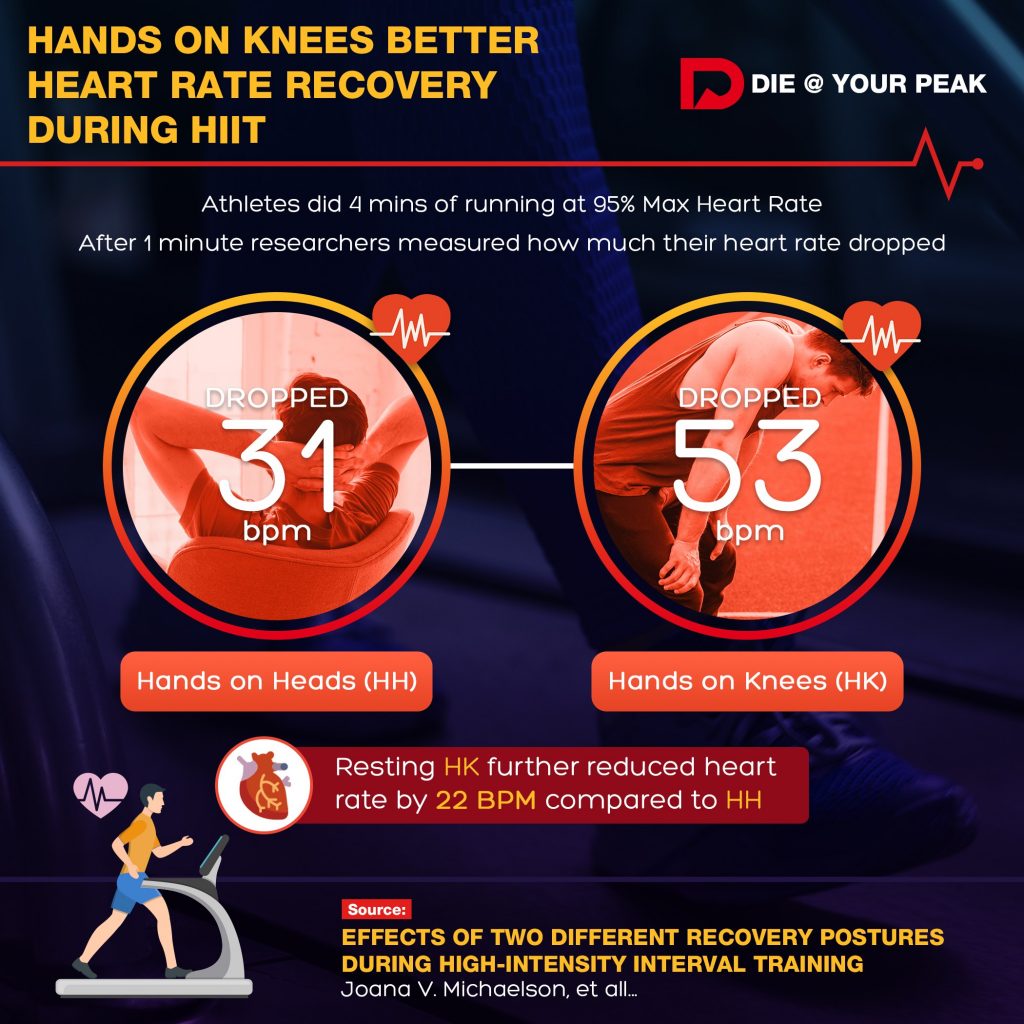TLDR
Resting your hands on your knees when tired from exercise is better for heart rate recovery than resting them on your head. Even better is to lay down.
Introduction
When I played tennis in high school I remember my coach giving me shit for resting my hands on my knees when I was winded. He would tell my teammates and I to put our hands on our heads so we could open up our chest and allow more oxygen in. It sounded reasonable so we complied. However, based on a recent study it turns out this posture is NOT the best for catching your breath and bringing your heart rate back down (AKA heart rate recovery).
Surprisingly, being bent over with our hands on our knees is the better recovery posture. If you think about it, resting your hands on our knees when tired just comes natural to humans. We aren’t implicitly taught this posture we just go to it when do get tired. But of course all the coaches and trainers out there still insist, like an urban legend, the advice to put your hands on your head.
For those of you who don’t want to read the study let me highlight the important parts.
Hands on Head (HH) vs Hands on Knees (HK) Recovery Posture During High-Intensity Interval Training (HIIT) Study
Who Was Tested
20 female Division II varsity soccer players participated in the study
How and What They Tested
4 intervals of 4 minutes of running on a treadmill at a pace of 90% – 95% of their maximum heart rate. In between each interval they had 3 minutes of passive rest. One minute (60 seconds) into three minute recovery their heart rate was logged (this is their Heart Rate Recovery or HRR). In addition they wore breathing masks which measured their Volume of CO2 (VCO2) and tidal volume (VT) at the end of their rest.
I wasn’t sure what Volume of CO2 or tidal volume was so I looked it up:
- Volume of CO2 – how much CO2 is being exhaled during recovery
- Tidal Volume – “Tidal volume is defined as the volume of air moved into and out of the lungs during each ventilation cycle.” (source)
For the purposes of the study the better posture should have for recovery should have:
- Higher heart rate recovery – means heart rate came back down to a lower rate
- Higher Volume of CO2 – means you are making more room for oxygen by exhaling more CO2
- Higher Tidal Volume – means you are moving more air in with each breath
Study Results

Hands on Knees beat Hands on Head in three measured metrics of recovery:
- Heart Rate Recovery: HK was 53 bpm vs HH was 31 bpm – difference of 22 bpm
- Volume of CO2: HK was 1.44 L/min vs HH was 1.34 L/min – difference of 0.10 L/min
- Tidal Volume: HK was 1.13 L/min vs HH was 1.03 L/min – difference of 0.10 L/min
The biggest and most significant result from these 2 postures was the improvement of heart rate recovery. They think the reason for the improved Heart Rate Recovery is because of autonomic response by bending over which affects the parasympathetic response.
In other previous studies they’ve compared heart rate recovery with standing, sitting, and laying down. It showed, unsurprisingly, sitting is better than standing and laying down is better than sitting for recovery.
Conclusion
It’s pretty clear that if you want to bring your heart rate back down fast during exercise then you should put your hands on your knees. Or even better, if your sport or gym allow it, lay down after an intense bout of exercise. You definitely don’t get cool points and people might think you are weak or lazy, but at least you’ll get better recovery!


Interesting. I’ve never before heard any talk or debate about where to put one’s hands when recovering from a workout. My workouts are usually either indoor rowing or using a cross country ski machine though and so my recovery/warm down is usually just doing whichever one of those it had been, but a lot more slowly as I warm down.
Either of you guys have to cope with any atrial fibrillation? That’s my workout spoiler lately. (If you want to answer directly you can either email or contact me through my website, neither of which is in this comment but which are provided in the fields below this comment.
-John
Thanks for the input John. When I mention “recovery” it’s more for recovering between intense intervals. For example if you were doing 250 meter row sprints for 5 rounds with 2 minutes of rest in between rounds then using this “hands on knee” technique would be good to bring your heart rate back down faster than if you were to put your hands on your head during your rest period.
As for atrial fibrillation we’ve been fortunate not to have to deal with that. But my father has had that issue. He recently had ablation done to help correct it. Immediately after the ablation it seemed to reduce the number of episodes he’s had. However, they are still monitoring him longer to see if overall he has less episodes. Maybe something look into for yourself if you haven’t already.
The heart rate recovery difference between HK and HH was 22 beats per minute, not 19.
-a different John
Great catch. Messed up the math. Have updated!